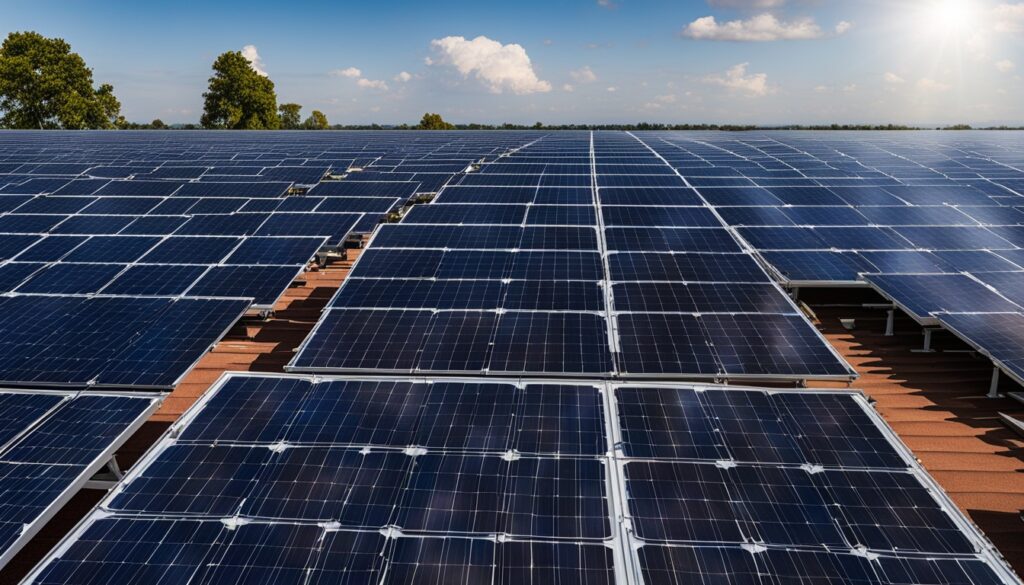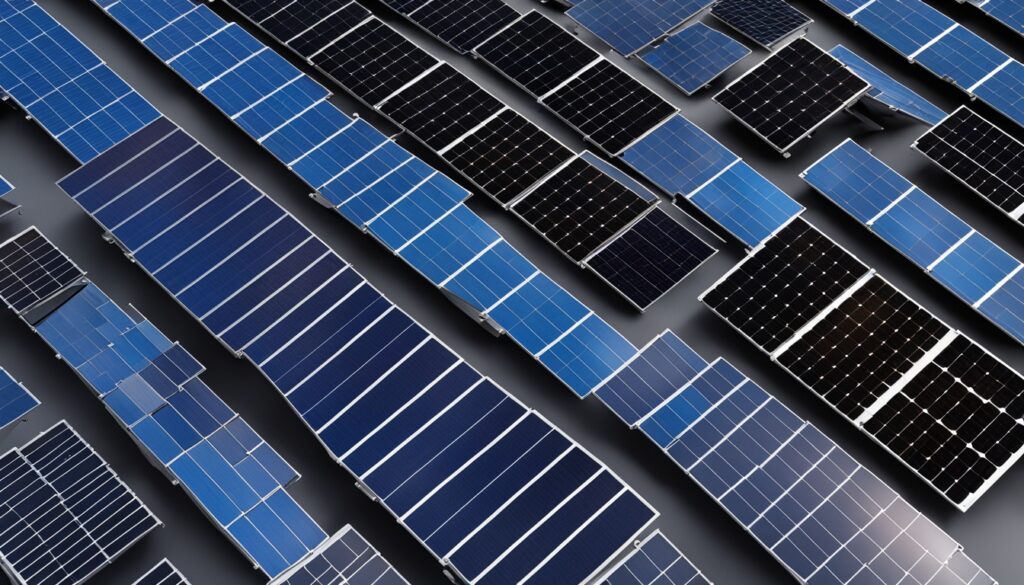The solar energy industry has grown a lot in the last ten years. It has expanded by nearly 50%. This growth is thanks to more people using solar power and other renewable sources. The Solar Investment Tax Credit has helped a lot. At the center of this growth are solar panels. They take in sunlight and turn it into electricity. Made of solar cells that contain layers of silicon, boron, and phosphorus. These layers work together to make electricity, a process called the photovoltaic effect. Today, there are many different types of solar panels to choose from, each with its unique features.
Key Takeaways
- The solar energy industry has experienced significant growth, driven by increased adoption of renewable energy sources like solar power.
- Solar panels are composed of individual solar cells made from materials like silicon, boron, and phosphorus that generate electricity through the photovoltaic effect.
- There are several different types of solar panel technologies available on the market, each with unique characteristics and applications.
- Mainstream solar panel technologies include monocrystalline silicon, polycrystalline silicon, and thin-film modules.
- Advanced high-efficiency solar panel technologies include gallium arsenide, multi-junction, and PERC modules.
What is a Photovoltaic (PV) Module?
A photovoltaic (PV) module is what we commonly call a solar panel. It’s a system of solar cells linked together. These cells catch sunlight and change it into electricity. A standard solar panel has between 60 to 90 cells, each one using special materials like silicon, boron, and phosphorus. When the sun’s ray hits a cell’s surface, it frees electrons in the silicon. This creates electric flow, usable to power gadgets or upload onto the electrical grid. We use the term photovoltaic effect to describe this process. This is how solar modules make electricity.
Definition of a Photovoltaic Module
A photovoltaic (PV) module or solar panel takes sunlight and changes it straight into electrical power. It’s the core of a solar power setup, offering clean and sustainable power for many needs.
Components of a PV Module
A PV module’s main parts are the solar cells. These are built from special materials as we discussed. There’s also a protective glass, a metal frame, and the necessary electrical links. These help the module to work, producing and moving electricity.
Function of a PV Module
The key job of a PV module is to turn sunlight into electricity through the photovoltaic effect. Light stimulates the electrons in the cells. This makes them move, creating electric power that we can use for devices or the electrical grid.

pv module types
The solar energy field has many photovoltaic (PV) module technologies. Each type has unique features and is useful for different things. Some common PV module types include monocrystalline silicon, polycrystalline silicon, and thin-film technologies.
Monocrystalline Silicon PV Modules
Monocrystalline silicon PV modules come from high-purity silicon wafers. These wafers grow from a unique, continuous crystal. This process makes solar cells look black and usually have higher efficiency. They’re great for rooftops since they produce a lot of power in a small space.
Polycrystalline Silicon PV Modules
Polycrystalline silicon PV modules use silicon wafers with many small crystals. This makes them less costly to produce than monocrystalline modules. Even though they’re slightly less efficient, they are recognized by their blue color. They are used in homes and large solar projects.
Thin-Film PV Modules
Thin-film PV modules use semiconductor materials in thin layers. These materials include amorphous silicon, cadmium telluride, or copper indium gallium selenide (CIGS). They’re made on glass or flexible plastic. While less efficient than other types, they are a good budget option for some uses, like on buildings.
Amorphous Silicon Thin-Film Modules
Amorphous silicon thin-film modules use a non-crystalline form of silicon. This is a simpler and cheaper way to make solar cells. They are less efficient but work well in low light. You often see them in items like small electronics.
Cadmium Telluride Thin-Film Modules
Cadmium telluride (CdTe) thin-film modules use a cadmium semiconductor. They are cheap to make and can be as efficient as polycrystalline silicon. However, the use of cadmium is a worry. That’s why alternative technologies, like CIGS, are being developed.
Copper Indium Gallium Selenide Thin-Film Modules
Copper indium gallium selenide (CIGS) thin-film modules are made with several metals. These have a chance for very high efficiency. They are often found in buildings and in small, portable solar systems.
Each PV module has its pros and cons, suiting different needs. The choice depends on how efficient, costly, and suitable it is for the situation.
High-Efficiency PV Module Technologies
There are many top-notch photovoltaic (PV) module types beyond the common ones. These technologies use special materials and designs. They greatly boost solar energy conversion.
Gallium Arsenide PV Modules
One exciting type is gallium arsenide (GaAs) PV modules. GaAs is a special semiconductor that’s better than silicon in some ways. It can absorb more solar rays. These modules can reach over 28% in conversion efficiency – the best out there. Yet, they’re mostly used in space and high-tech systems because they’re costlier.
Multi-Junction PV Modules
There’s also the multi-junction solar cell. They layer different semiconductors to take in more of the sun’s spectrum. This way, they can beat 30% efficiency in energy conversion. Even though they’re expensive to make, they are perfect for special tasks. This includes aerospace and defense, where every gram and inch matters.
Passivated Emitter and Rear Cell (PERC) Modules
The passivated emitter and rear cell (PERC) module is newer but already making a big change. It uses a smart back surface to not lose light. This increases its efficiency up to 22%, a lot better than usual solar cells. Now, these PERC modules are growing in popularity. They make solar panels more efficient without being too pricey.
These top-level PV technologies are at the forefront of solar power. They show just how far we can go in turning sunlight into electricity. They might be more expensive, but their results are worth it. They’re great for applications needing maximum energy.
Conclusion
The solar industry is growing fast, thanks to more people choosing renewable energy. Governments are also helping through incentives. At the heart of this growth are PV modules, known as solar panels. They turn sunlight into electricity using the photovoltaic effect. Different types of PV modules offer various levels of efficiency, cost, and uses.
There are traditional crystalline silicon panels and newer high-efficiency ones. The industry is always improving and making renewable energy cheaper. This trend is making solar power a better choice for everyone, from homes to big companies. In places like India, solar power is truly taking off.
The solar industry is strong and always changing for the better. Thanks to new technology and supportive policies, it’s making a big mark. Soon, it will be a major player in providing the clean energy the world needs.
FAQ
What is a Photovoltaic (PV) Module?
A photovoltaic (PV) module, or solar panel, gathers sunlight with solar cells. These cells turn the sunlight into electricity by a process called the photovoltaic effect.
What are the main components of a PV Module?
Solar panels have many solar cells. They use materials like silicon, boron, and phosphorus to create energy from the sun’s rays.
How does a PV Module generate electricity?
Sunlight hits the solar cells’ surface. This action knocks electrons free from the silicon. That creates an electric current we can use to power our devices or share with the grid.
What are the main types of PV Module technologies?
The market offers monocrystalline silicon, polycrystalline silicon, thin-film, and high-efficiency PV modules.
What are the characteristics of monocrystalline silicon PV Modules?
Monocrystalline silicon modules come from single silicon crystals. They look black and reach high efficiency levels, from 15-22%.
What are the characteristics of polycrystalline silicon PV Modules?
Polycrystalline silicon modules are from many fused silicon crystals. They look blue and have efficiencies between 13-16%, slightly lower than monocrystalline.
What are the characteristics of thin-film PV Modules?
Thin-film modules use materials like amorphous silicon, cadmium telluride, or CIGS. They’re less efficient, from 10-15%, but are affordable and flexible.
What are the characteristics of high-efficiency PV Module technologies?
High-efficiency modules use advanced tech like gallium arsenide and PERC. They can reach an efficiency of 20-30%. These modules are usually more costly.

